Introduction
Until now, the traditional medicine based on the herbal treatment would play a significant role in human’s health care [1]. Especially, lots of plants for medicine have been gaining wider acceptance, because it is natural production. Furthermore, various medicinal plants have a few side effects and higher efficiency than the artificially synthesized chemicals [1]. In fact, over 80% of the world’s people would rely on traditionally plant-derived medicines which are the primary ways for healing their health [1].
Among them, clove (Syzygium aromaticum; (synonym) Eugenia cariophylata) is a significant medicinal plant which is widely used in folk medicine in many nations, because of its wide broad of various pharmacological functions [2]. Generally, clove is an medium size tree (8–12 m) from Mirtaceae family native from the Maluku islands in east Indonesia, Brazil, Sri Lanka, Madagascar, Tanzania, and so on [2,3].
Especially, the clove essential oil was generally extracted from the dry floral bud of the clove tree, and has various biofunctional activities on account of the presence of eugenol (C10H12O2) and other phenolic compounds [4]. For example, clove coil could act as a bactericidal activity against various foodborne pathogens and as an antifungal activity against Candida, Aspergillus niger, Fusarium oxysporum, and so on [2,4–9]. Also clove oil would have the anti-free radical and metal chelating function [4].
And the clove oil derived from Syzygium aromaticum has eugenol which could have many biofunction effects, for example, anaesthetic, analgesic, anti-cancer, anti-inflammatory, antioxidant, antiseptic, medical dental practice, and so on, and furthermore, clove oil is widely used to cure lots of diseases such as acne, allergies, asthma, rheumatoid arthritis, scarring, warts, etc. [2,10–15]. According to the safety of eugenol and clove oil reported by Hu et al. [14], after 28 days of injecting clove extract (about 2.5 g/kg body weight) into mice, there was no toxicity or damage. Furthermore, So far there have been no reports of human damage caused by eugenol and clove oil [14]. The various biological activities of Syzygium aromaticum and its related compounds are shown in Fig. 1.

Consequently, because clove oil has multifunctional potential, clove oil could be supplemented directly to milk products so as to improve the sensory attributes and upgrade the health benefits of people. Hence, the objective of this study is to screen the organoleptic attributes by adding clove oil of different concentrations to milk products such as market milk, yoghurt and Kefir, and also to investigate the antibacterial activities against Cronobacter sakazakii and Salmonella Enteritidis by using clove oil.
Materials and Methods
In this study, Clove oil (Syzygium aromaticum, L.) purchased from Live Natural Clove Oil 30 mL manufactured in Hermani General Trading LLC (UAE). Clove oil used in this study consists of 100% clove oil as food additive grade. The various concentration of clove oil was prepared using a concentrator.
Two foodborne bacteria used in the study were prepared with the contribution of Center for One Health, Konkuk University in Seoul, South Korea. Cronobacter sakazakii KCTC2949 and Salmonella Enteritidis 110 were grown on nutrient agar (Oxoid, UK) at 37°C for one day. Colonies were transferred into tubes containing cryopreservation fluid and the beads were stored at –70°C until use. Antibacterial activity of clove oil were tested on two major foodborne bacteria using the spot-on-lawn method [16]. Cronobacter sakazakii KCTC2949 and Salmonella Enteritidis 110 were cultured on MuellerHinton broth (MHB; Difco, USA) and incubated at 37°C for one day. The culture broth was diluted using MHB to 0.5 McF and spread onto Mueller-Hinton agar (MHA; Difco) using sterilized cotton swabs. A total of negative control (without clove oil) and clove oil was directly dropped onto the surface of the MHA, respectively. The plates were incubated at 37°C for one day and then the zone of inhibition was observed.
Various milk products including market milk (Seoul Dairy, Korea), yoghurt and kefir was supplemented with various concentrations (control, 0.5%, 1.0%, 1.5%, and 2.0%) of clove oil, and then mixed thoroughly. Then, the market milk, yoghurt, and kefir supplemented with clove oil kept in refrigerator until analyzed. All samples such as market milk, yoghurt and Kefir were manufactured according to the method of Chon et al. [17].
pH value of market milk, yoghurt and kefir supplemented with clove oil was analyzed by Thermo Scientific™ Orion™ Star A211 pH Benchtop Meter (Thermo Fisher Scientific, USA).
After making various milk products such as market milk, yoghurt and Kefir supplemented with clove oil, it was kept at 5°C until analyzed. The panel comprising of 10 trained researcher was employed for the evaluation of market milk, yoghurt and Kefir supplemented with clove oil. The 10 panelists were preferred and trained to be expert on analysis of sensory attributes. In this study, the samples were randomly tested in disposable plastic cups (50 mL) at 10°C. The sensory attributes was five-point hedonic value was rated 1 (extremely poor), 2 (poor), 3 (fair), 4 (good), and 5 (excellent), and was consisted of five sensory attributes including taste, flavor, color, texture and overall acceptability.
The results in this study were taken from duplicate in two separate experiments, and were assessed by the statistical software (GraphPad Prism 5, GraphPad Softward, USA). All results were exhibited as means. Significant differences were evaluated using Fisher’s least significant difference tests. Results with value “p<0.05” was considered significant.
Results and Discussion
The result of clove oil demonstrated the antibacterial activity tested by the spot-on-lawn method (Table 1). The results obtained presented that clove oil showed antibacterial activity against Cronobacter sakazakii KCTC2949 and Salmonella Enteritidis 110, simultanously (Table 1). To the extent we know, this is the first study to report the antibacterial activity against Cronobacter sakazakii using clove oil.
| Bacteria\Type | Clove oil (Syzygium aromaticum) | |
|---|---|---|
| With addition | Without addition | |
| Cronobacter sakazakii | − | + |
| Salmonella Enteritidis | − | + |
| Negative control | + | + |
According to Puškárová et al. [7], antimicrobial activity of clove essential oil was demonstrated against Escherichia coli, Listeria monocytogenes, Pseudomonas fragi, Salmonella Typhimurium, Staphylococcus aureus, Yersinia enterocolitica, and so on [2,4,5,7,9]. Also clove essential oil exhibited the antifungal effects against Alternaria alternate, Aspergillus fumigatus, Candida albicans, Chaetomium globosum, Cladosoprium cladosporoides, Epidermophyton floccosum, Microsporum audouinii, Penicillium chrysogenum, Trichophyton mentagrophytes, Trichophyton rubrum, and so on [5–9]. Also, according to report of Chaieb et al. [15], the biological function of clove essential oil had the ability to control foodborne pathogenic bacteria, parasites, Herpes simplex and hepatitis C virus, and so on [15]. In foodborne pathogenic bacteria, the result of this study was similar to that of previous studies.
pH value of market milk, yoghurt, and kefir was 6.65, 3.68, and 4.33, respectively (Fig. 2), and pH value of clove oil was approximately 4.69 (data not shown). In this study, pH value of market milk, yoghurt and Kefir supplemented with various concentrations (control, 0.5%, 1.0%, 1.5%, and 2.0%) of clove oil exhibited similar to that of market milk, yoghurt and Kefir without addition of clove oil (Fig. 2). Hence, there was no statistical significant difference between treated group and control group conducted.
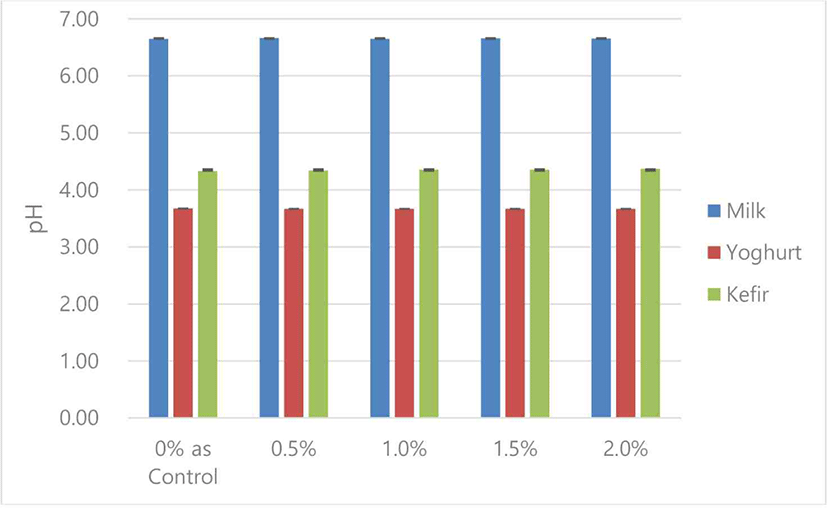
Zahid et al. [18] reported that a non-significant difference in pH values was seen among all types of patties supplemented with clove extract for refrigerated storage at 1 and 5 days. Hence, this showed a similar tendency to this experiment.
According to Chaieb et al. [15], the primary constituents of clove oil is generally considered to be eugenol, with β-caryophyllene and lesser amounts of other constituents such as benzyl alcohol, but the proportions vary widely [15]. Especially, eugenol is the primary bioactive elements of clove with concentration ranging from 9,382 to 146,500 mg per 100 mg of fresh plant materials [3].
Fig. 3 showed the summary of sensory attributes of market milk evaluated by ten persons. Market milk was supplemented with various concentrations (control, 0.5%, 1.0%, 1.5%, and 2.0%) of clove oil. The taste score was from 2.6 to 1.6, which was lower than 3.4 of control group. The flavor value was 3.0 to 1.625, which was lower than 4.125 of control group. The color value was from 3.0 to 1.25, which was lower than 4.25 of control group. The texture value was from 3.25 to 2.25, which was lower than 3.875 of control group. And the overall acceptability value was from 3.125 to 1.625, which was lower than 4.125 of control group.
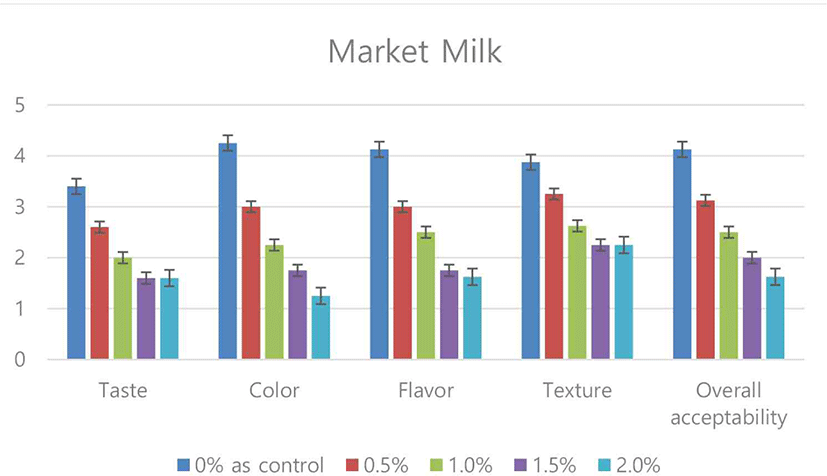
According to statistical analysis on the sensory attributes market milk, there was a statistically significant difference in taste, flavor, color, texture and overall acceptability between treated group and control group (p<0.05). As the addition of clove oil increased, the category of taste, flavor, color, texture and overall acceptability tended to decrease. Among the treated group, the market milk supplemented with 0.5% of clove oil demonstrated the best results compared with control group.
Fig. 4 showed the summary of sensory attributes of yoghurt evaluated by ten persons. Yoghurt was supplemented with various concentrations (control, 0.5%, 1.0%, 1.5%, and 2.0%) of clove oil. The taste value was from 1.8 to 1.4, which were similar or lower than 2.2 of control group. The flavor value was from 2.215 to 1.5, which were similar or lower than 2.215 of control group. The color value was from 3.0 to 2.875, which were lower than 3.125 of control group. The texture value was from 3.0 to 2.625, which were higher than 1.625 of control group. And the overall acceptability value was from 2.375 to 2.0, which were higher or similar than 2.0 of control group.
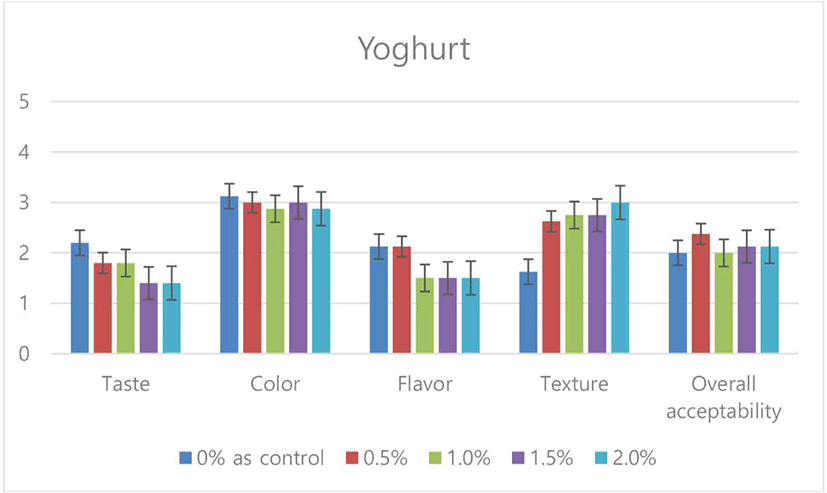
According to the analysis of statistical characteristics on the sensory attributes of yoghurt, except color and overall acceptability, there was a statistically significant difference in taste, flavor, and texture between treated group and control group (p<0.05). As the addition of clove oil increased, the category of taste, flavor, and color tended to decrease except texture and overall acceptability. Among the treated group, the market milk supplemented with 1.0% of clove oil demonstrated the best results compared with control group.
Fig. 5 showed the summary of sensory attributes of kefir evaluated by ten persons. Kefir was supplemented with various concentrations (control, 0.5%, 1.0%, 1.5%, and 2.0%) of clove oil. The taste value was from 2.6 to 2.2, which were lower than 2.8 of control group. The flavor value was from 2.0 to 1.75, which were lower than 2.75 of control group. The color value was from 4.0 to 3.125, which were lower than 4.25 of control group. The texture value was from 4.125 to 3.875, which were higher than 3.75 of control group. And the overall acceptability value was from 3.0 to 2.5, which were lower than 3.625 of control group.
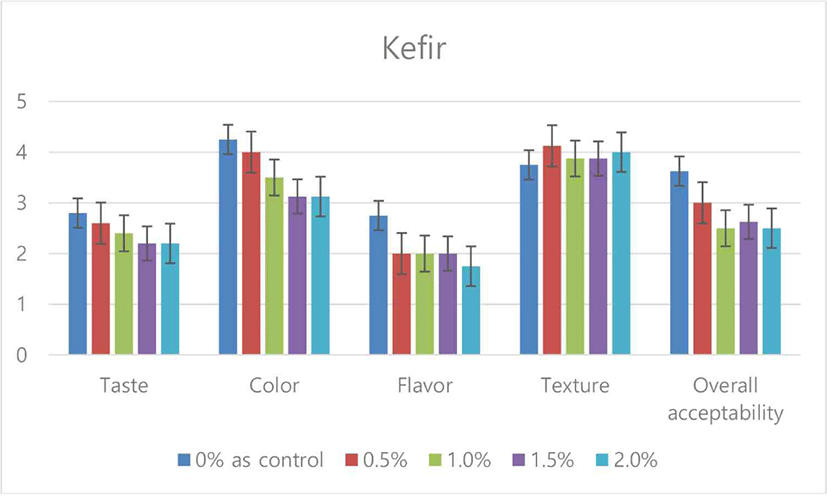
According to the analysis of statistical characteristics on the sensory attributes of kefir, there was a statistically significant difference in taste, flavor, color, texture and overall acceptability between treated group and control group (p<0.05). As the addition of clove oil increased, the category of taste, flavor, color, and overall acceptability tended to decrease except texture. Among the treated group, the market milk supplemented with 0.5% or 1.0% of clove oil demonstrated the best results compared with control group.
Until now, there has been no research to supplement clove oil to the kefir, this study is believed to have very valuable significance as the first study to prove the usability of the kefir using clove oil.
Also, Fig. 6 exhibited the color trend in market milk, yoghurt, and Kefir supplemented with various concentrations of clove oil. This study showed that market milk, yoghurt, and Kefir supplemented with different concentrations (control, 0.5%, 1.0%, 1.5%, and 2.0%) of clove oil were changed to light yellow in this study (Fig. 6). Hence, the color value of market milk, yoghurt and kefir supplemented with clove oil in sensory attributes were all low (Fig. 3–5).
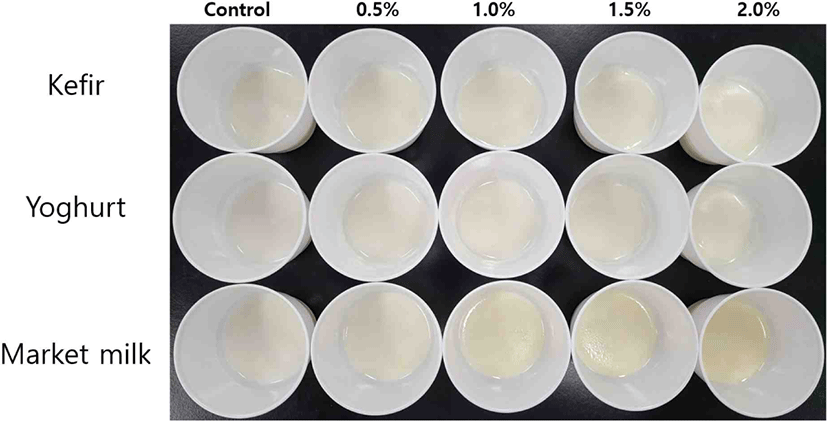
According to Marchese et al. [2], eugenol (C10H12O2) is a phenolic aromatic substance with a pleasant odor and taste, belonging to the allylbenzene class of phenylpropanoids. It is usually found in the form of a yellowish oily liquid, chemically expressed as 1-ally-4-hydroxy-3-methoxybenzene or 4-allyl-2-methoxyphenol, while it is also an allyl chain-substituted guaiacol [2]. Hence, Fig. 6 showed that as the addition of clove oil increased, the chromaticity of yellow increased. This showed a similar tendency to this experiment.
However, according to Radünz et al. [4], owing to clove oil’s instability, odor, and volatility under room circumstance (light, oxygen, temperature, and so on), clove oil’s use in the food-related industry is limited [4]. Hence, similarly in this study, the flavor value of market milk, yoghurt, and kefir was generally lower compared to the control group (Fig. 3–5).
Zahid et al. [18] reported that the sensory assessment regarding overall color, discoloration, and odor demonstrated that clove extract inclusion in patties extended the storage life up to 10 days, hence, the application clove extract such as the natural antioxidant could result in reduced protein and lipid oxidation and then could enhance the quality of cooked patties. Also Aliakbarlu et al. [19] showed that the sensory evaluation of raw ground sheep meat supplemented with clove essential oil for 9 days of the storage of refrigerator. The addition of clove essential oil would have an outstanding effect on the color and odor characteristics of ground sheep meat, and also would improve the overall acceptability score, too [19]. Sharma et al. [20] studied that the clove essential oil was incorporated at four different level (0.125%, 0.25%, 0.5%, and 1%) in fresh chicken sausages. Sensory scores for general appearance did not significantly differ between control and treatment products which might be due to inhibition of metmyoglobin formation by eugenol the change in color of sausage [20]. Namely, only clove essential oil concentration lower than or equal to 0.25% could be organoleptically acceptable, not exceeding of the flavor acceptability threshold observed by the panelists, so they could be used as preservatives or food additives [20]. Pagthinathan [21] demonstrated that the sensory properties of clove oil supplemented butter samples were evaluated on the attributes of color, appearance, taste, flavor, texture, and overall acceptability for 8 weeks of the storage. Sensory properties of the butter samples were found to be affected significantly by the addition of clove oil [21]. In overall quality, 0.5% clove oil had more preference for sensory properties among the panelist during the storage period [21]. This showed a similar tendency to this experiment.
Clove is now widely used in various foods, for example, cloves could be used for making of safety and good quality cakes [22].
In conclusion, according to clove oil has outstanding effect with significant nutritional characteristics and biofunctional potentials, clove oil might be efficient for enhancing the human health [22]. Future research will have to focus on manufacturing multipurpose milk products using clove oil.






